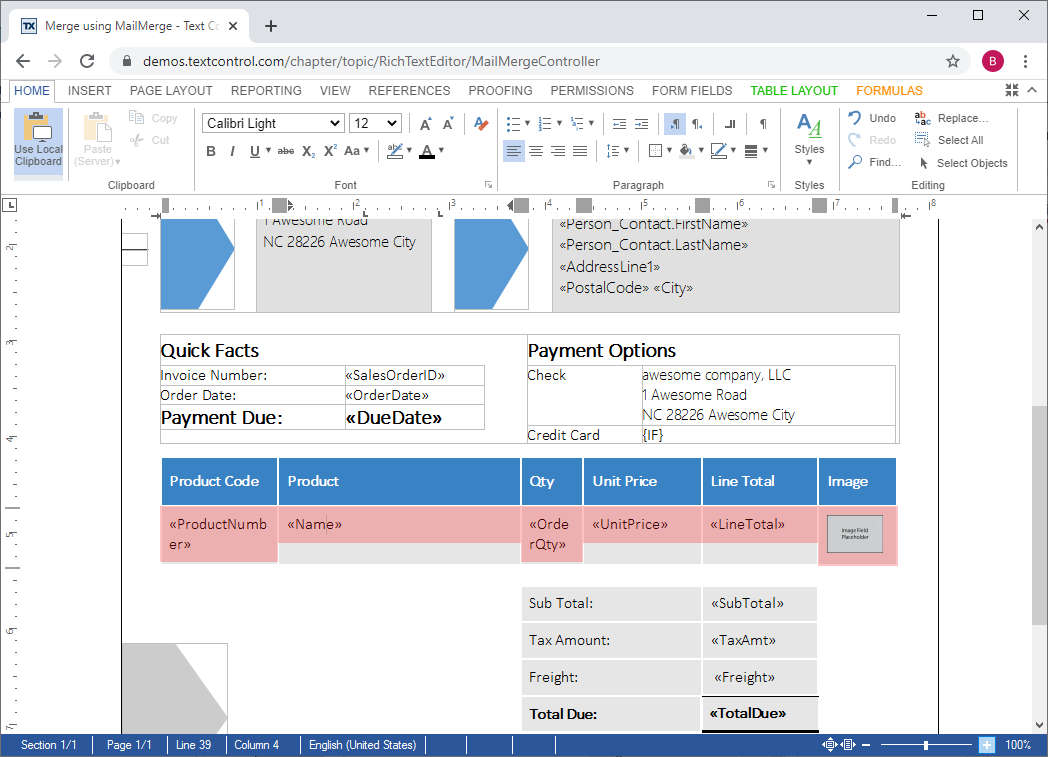Text Control products can be used to create documents programmatically from scratch, pre-designed templates can be used to populate merge fields using the Mail
╰ DocumentServer Namespace
╰ MailMerge Class
The MailMerge class is a .NET component that can be used to effortlessly merge template documents with database content in .NET projects, such as ASP.NET web applications, web services or Windows services. class and documents can be edited using true WYSIWYG rich text controls for ASP.NET Core, Angular, Windows Forms and WPF.
- Create, edit, load and save MS Word documents (DOC, DOCX, RTF).
- Fully-featured document API to automate documents.
- Merge data from multiple data sources into templates with placeholders.
- Deploy TX Text Control within your application.
Creating Documents From Scratch
TX Text Control provides a powerful and complete API to create and manipulate documents programmatically. This API can be used in any .NET application such as Windows applications, Windows Service applications or web services.
The following code creates a new instance of Server
╰ TXTextControl Namespace
╰ ServerTextControl Class
The ServerTextControl class implements a component that provide high-level text processing features for server-based applications. which is the non-visual Text Control. The API is compatible to the visual controls such as the Windows Forms TXTextControl.TextControl class, the WPF TXTextControl.WPF.TextControl class or the online editor using JavaScript.
The following code inserts a paragraph, a table and exports the document as an MS Word DOCX and Adobe PDF document:
| using (ServerTextControl tx = new ServerTextControl()) | |
| { | |
| tx.Create(); | |
| // create a new selection range | |
| Selection range = new Selection(); | |
| range.Bold = true; | |
| range.FontSize = 400; | |
| range.Text = "This is a new paragraph\r\n"; | |
| // insert the range to the document | |
| tx.Selection = range; | |
| // add a table | |
| tx.Tables.Add(5, 5, 10); | |
| foreach (TableCell cell in tx.Tables.GetItem(10).Cells) | |
| { | |
| cell.Text = cell.Row.ToString() + ", " + cell.Column.ToString(); | |
| } | |
| // save the document as DOCX | |
| tx.Save("test.docx", StreamType.WordProcessingML); | |
| // save the document as PDF | |
| tx.Save("test.pdf", StreamType.AdobePDF); | |
| } |
Merging Templates Using MailMerge
After a template has been successfully designed in one of the visual document editors of TX Text Control, the reporting engine MailMerge can be used to merge data into placeholders. For each data row of the master table in the data source, a document is created. Merge fields are populated with column values and repeating blocks are merged with data rows of related child tables in the data source.
The following code creates an instance of the reporting engine MailMerge to merge the template that is loaded into a ServerTextControl with an IEnumerable object. Finally, the document is exported as a PDF document:
| // create a business object that is used | |
| // as the data source | |
| Invoice invoice = new Invoice() { Name = "Report" }; | |
| using (ServerTextControl tx = new ServerTextControl()) | |
| { | |
| tx.Create(); | |
| LoadSettings ls = new LoadSettings() { | |
| ApplicationFieldFormat = ApplicationFieldFormat.MSWord | |
| }; | |
| // load the created template | |
| tx.Load("template.docx", StreamType.WordprocessingML, ls); | |
| // create a new MailMerge engine | |
| using (MailMerge mailMerge = new MailMerge()) | |
| { | |
| // connect to ServerTextControl | |
| mailMerge.TextComponent = tx; | |
| // merge the template that is loaded with | |
| // the business object | |
| mailMerge.MergeObject(invoice); | |
| } | |
| // export the document as PDF | |
| tx.Save("test.pdf", StreamType.AdobePDF); | |
| } |
Visual Document Editor
The RibbonReportingTab represents a ribbon tab to integrate mail merge and reporting functionality directly into your TX Text Control based application. Together with all other ribbon tabs known from typical word processors, creating MS Word compatible template designers and word processors is a very easy task.
Not being dependent on an additional third-party tool such as MS Word to create templates is a very important key aspect when implementing word processing functionality into business applications. The MS Word compatible editor has the look and feel of MS Word, but can be customized and adapted to user requirements. MS Word templates can be reused and edited in TX Text Control.
The following screenshot shows the ASP.NET Core document editor of TX Text Control. The visual controls can be automated in the same way like the non-visual class ServerTextControl using the same, compatible API.

Text Control provides the most powerful tools and controls to integrate document creation processes into any kind of business applications.
Open the online demos to learn how TX Text Control can help you integrating document processing into your applications:

